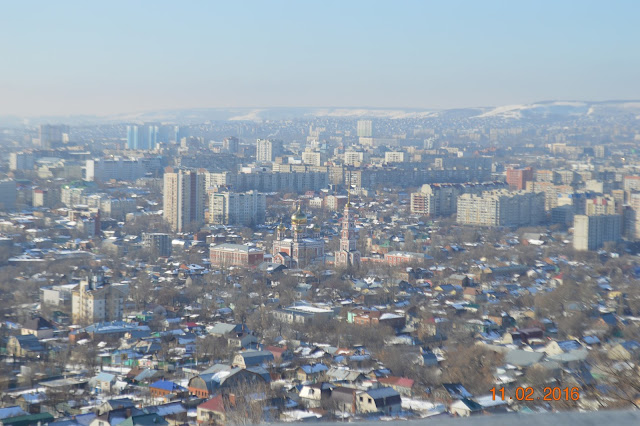Daily Living in Winter
 |
| Source: 2016 MKB-DESKKART and SerialInternet https://www.welt-atlas.de/map_of_russia_5-720 |
Since Saratov is a sizeable city of 820,000 inhabitants, one can expect excellent public transportation in the city and surrounding areas. The city does not disappoint--an inexpensive bus, electric bus, minibus and streetcar network system does exist. Some of the buses held a surprise for me--they were equipped with German signs. It turns out that the city has bought some buses that were used in Germany prior to here as was explained to me. There is also an interesting minibus system in place--vans equipped with seats that connect areas with fewer people to the city center. I was assured, however, that sometimes these vans can hold an awful lot of people. When I was on board of such a van, the population density within the van was fine, actually much better than in the buses that were often quite crowded.
Getting around is not all that easy in the winter. The sidewalks are usually quite icy, but not always. It is particularly hard to get around when there is fresh snow on the ground and one cannot distinguish between snow (which does give traction) and ice underneath the snow--all the traction in the world won't save you from that inevitable fall! Live and learn and watch the people...so my eyes have been more on the pavement than on the city sights since I usually choose to walk the 40 minutes to work. During snowfall that walk can get long. I have seen a snow plow in action on sidewalks but it made things worse, not better. There is no sand or, God forbid, salt. I do have to say people are very adapt at driving on the roads in all conditions--not sure what their secret is but it's got something to do with good tires, I am sure. Often, the city also experiences thawing temperatures like today which adds slush to the mix. I am sure in the Washington D.C. area this would all be happy snow days.
Getting around is not all that easy in the winter. The sidewalks are usually quite icy, but not always. It is particularly hard to get around when there is fresh snow on the ground and one cannot distinguish between snow (which does give traction) and ice underneath the snow--all the traction in the world won't save you from that inevitable fall! Live and learn and watch the people...so my eyes have been more on the pavement than on the city sights since I usually choose to walk the 40 minutes to work. During snowfall that walk can get long. I have seen a snow plow in action on sidewalks but it made things worse, not better. There is no sand or, God forbid, salt. I do have to say people are very adapt at driving on the roads in all conditions--not sure what their secret is but it's got something to do with good tires, I am sure. Often, the city also experiences thawing temperatures like today which adds slush to the mix. I am sure in the Washington D.C. area this would all be happy snow days.
Much of the city's population lives more along the outskirts in 5-floor (no elevators) and 9-floor Soviet-style housing but probably just as many people live in more modern highrises, between 10 to 25 floors high--and, yes, these have all elevators.
Many of those new high rises contain apartments that are sold as condominiums. Often, one locks in / buys such a condominium about 2 years before the building's completion. Apart from weight-bearing walls, the owners can create their own space including the position of the walls. One family might want a large living space, another three instead of two bedrooms etc. These apartments are quite spacious; on the upper floors one also has a great view of the city and its surrounding hills. Can you tell I was in such an apartment?
 The original, old downtown area of Saratov consists of buildings with fewer floors (3-5) (as seen in photo in the foreground) which is pretty much the reverse from the typical North American city with its CBD in the center consisting of high rises and stretched out suburban areas with its low-rise houses. Here we have a mix of older buildings with newer ones (see photos).
The original, old downtown area of Saratov consists of buildings with fewer floors (3-5) (as seen in photo in the foreground) which is pretty much the reverse from the typical North American city with its CBD in the center consisting of high rises and stretched out suburban areas with its low-rise houses. Here we have a mix of older buildings with newer ones (see photos).
There is a pedestrian street (inofficially called Nemetzkaya Ulitza-'German Street'; the official name on the sign says something totally different) in the heart of the city showcasing many interesting shops, also a conservatory.
 |
| An old sweets shop from Soviet times |




































